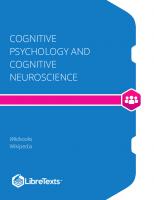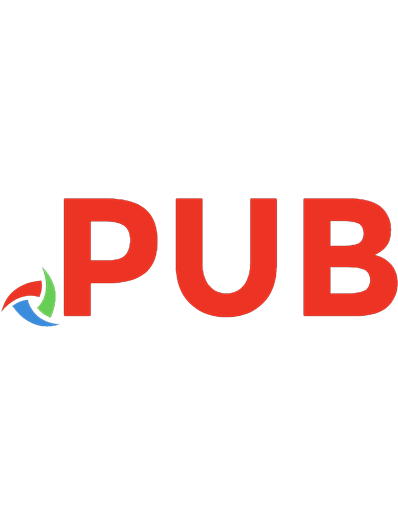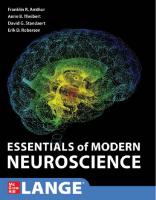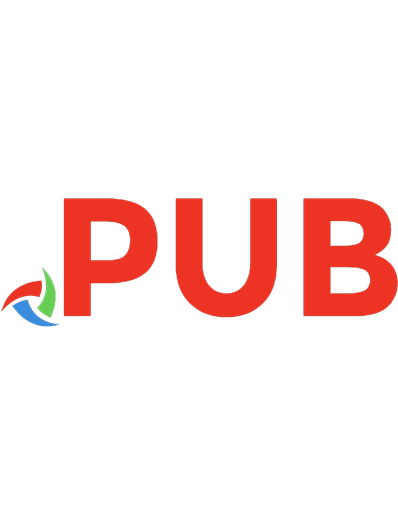Essentials of Cognitive Neuroscience, 2nd Edition [2 ed.] 9781119674153, 9781119674108, 9781119674092, 9781119607687
Essentials of Cognitive Neuroscience introduces and explicates key principles and concepts in cognitive neuroscience in
277 10 31MB
English Pages 560 [558] Year 2020
Table of contents :
Cover
Title Page
Copyright
Brief Contents
Contents
Preface
Acknowledgments
Walkthrough of Pedagogical Features
Companion Website
Section I: The Neurobiology of Thinking
Chapter 1 Introduction and History
Key Themes
A Brief (and Selective) History
Construct validity in models of cognition
Localization of function vs. mass action
The first scientifically rigorous demonstrations of localization of function
The localization of motor functions
The localization of visual perception
The localization of speech
What is a Brain and What Does It Do?
Looking Ahead to the Development of Cognitive Neuroscience
End-Of-Chapter Questions
References
Other Sources Used
Further Reading
Chapter 2 The Brain
Key Themes
Pep Talk
Gross Anatomy
The cerebral cortex
The Neuron
Electrical and chemical properties of the neuron
Ion channels
How neurons communicate: the action potential
How neurons communicate: the postsynaptic consequences of neurotransmitter release
Different neurotransmitters and different receptors can produce different effects on the postsynaptic cell
Synaptic plasticity
Housekeeping in the synaptic cleft
Oscillatory Fluctuations in the Membrane Potential
Neurons are never truly “at rest”
Oscillatory synchrony
Complicated, and Complex
End-of-Chapter Questions
References
Other Sources Used
Further Reading
Chapter 3 Methods for Cognitive Neuroscience
Key Themes
Behavior, Structure, Function, and Models
Behavior
Neuropsychology, neurophysiology, and the limits of inference
Many stimulation-based techniques share inferential principles with neuropsychology
The importance of specificity
Different kinds of neuropsychology address different kinds of questions
Cognitive neuropsychology
Experimental neuropsychology
Clinical neuropsychology
How does behavior relate to mental functions?
Methods for lesioning targeted areas of the brain
Stroke
Nonlocalized trauma
Focal lesions
Noninvasive methods to produce “virtual lesions”
Transcranial Neurostimulation
The importance of specificity (again)
Transcranial electrical stimulation
Transcranial direct current stimulation
Transcranial alternating current stimulation
Transcranial magnetic stimulation
Single-pulse TMS
“Virtual-lesion” TMS protocols
High-frequency repetitive (r)TMS
Anatomy And Cellular Physiology
Techniques that exploit the cell biology of the neuron
Tract tracing
Functional tissue imaging
Electrophysiology
Invasive recording with microelectrodes: action potentials and local field potentials
Electrocorticography
Electroencephalography
Magnetoencephalography
Invasive Neurostimulation
Electrical microstimulation
Optogenetics
Analysis of Time-Varying Signals
Event-related analyses
Advantages of the ERP technique
Caveats about the ERP technique
Considerations
Time–frequency analysis
Phase–amplitude coupling
Other measures of phase dynamics
Caveats and considerations for spectral analyses
Magnetic Resonance Imaging
Physics and engineering bases
MRI methods for in vivo anatomical imaging
T1-weighted imaging
Voxel-based morphometry
Diffusion tensor imaging – in vivo “tract tracing”
Functional magnetic resonance imaging
The metabolic demands of the action potential and of synaptic activity
T2*-weighted fMRI
Task-related functional imaging
Functional connectivity
Resting state functional correlations
Magnetic Resonance Spectroscopy
Tomography
X-ray computed tomography
Positron emission tomography
Near-Infrared Spectroscopy
Some Considerations for Experimental Design
Computational Models And Analytic Approaches
Neural network modeling
A PDP model of picture naming
Deep neural networks
Network science and graph theory
End-of-Chapter Questions
References
Other Sources Used
Further Reading
Section II: Sensation, Perception, Attention, and Action
Chapter 4 Sensation and Perception of Visual Signals
Key Themes
The Dominant Sense in Primates
Organization of the Visual System
The visual field
The retina and the LGN of the thalamus
The retinotopic organization of primary visual cortex
The receptive field
Information Processing in Primary Visual Cortex – Bottom-Up Feature Detection
The V1 neuron as feature detector
Columns, hypercolumns, and pinwheels
Inside the pinwheel
Information Processing in Primary Visual Cortex – Interactivity
Feedforward and feedback projections of V1
Corticothalamic loops, center-surround inhibition, and signal-to-noise ratio
Setting the state of thalamic neurons: tonic mode vs. burst mode
Circularity? It can depend on your perspective
The relation between visual processing and the brain’s physiological state
Where Does Sensation End? Where Does Perception Begin?
End-of-Chapter Questions
References
Other Sources Used
Further Reading
Chapter 5 Audition and Somatosensation
Key Themes
Apologia
Audition
Auditory sensation
What is it that we hear?
Mechanical transmission and neural transduction
Spectral decomposition performed by the basilar membrane
Auditory perception
The auditory-evoked response
The organization of auditory cortex
Top-down control of auditory transduction
Adieu to audition
Somatosensation
Transduction of mechanical and thermal energy, and of pain
Somatotopy
Somatotopy in the rodent: barrel cortex
Optogenetic exploration of gamma-band oscillations in somatosensory cortex
Somatosensory plasticity
Use-dependent plasticity
The brain mimics the body
Mechanisms of somatosensory plasticity
Phantom limbs and phantom pain
A hypothesized mechanism
Helpful or harmful?
Proprioception
Adieu to sensation
End-of-Chapter Questions
References
Other Sources Used
Further Reading
Chapter 6 The Visual System
Key Themes
Familiar Principles and Processes, Applied to Higher-Level Representations
Two Parallel Pathways
A diversity of projections from V1
A functional dissociation of visual perception of what an object is vs. where it is located
Interconnectedness within and between the two pathways
The Organization and Functions of the Ventral Visual Processing Stream
Hand cells, face cells, and grandmother cells
Electrophysiological recordings in temporal cortex
Broader implications of visual properties of temporal cortex neurons
A hierarchy of stimulus representation
Combination coding, an alternative to the “grandmother cell”
Object-based (viewpoint-independent) vs. image-based (viewpoint-dependent) representation in IT
A critical role for feedback in the ventral visual processing stream
Using deep neural networks to understand computations underlying object recognition
Top-down feedback can disambiguate the visual scene
Taking Stock
End-of-Chapter Questions
References
Other Sources Used
Further Reading
Chapter 7 Spatial Cognition and Attention
Key Themes
Unilateral Neglect: A Fertile Source of Models of Spatial Cognition and Attention
Unilateral neglect: a clinicoanatomical primer
Hypotheses arising from clinical observations of neglect
The Functional Anatomy of the Dorsal Stream
Coordinate transformations to guide action with perception
Extracellular electrophysiological studies of monkeys
From Parietal Space to Medial-Temporal Place
Place cells in the hippocampus
How does place come to be represented in the hippocampus?
The Neurophysiology of Sensory Attention
A day at the circus
Attending to locations vs. attending to objects
Mechanisms of spatial attention
Contradictory findings from fMRI vs. EEG?
Effects of attention on neuronal activity
Spatial attention
Object-based attention
Turning Our Attention to the Future
End-of-Chapter Questions
References
Other Sources Used
Further Reading
Chapter 8 Skeletomotor Control
Key Themes
The Organization of the Motor System
The anatomy of the motor system
The corticospinal tract
The cortico-cerebellar circuit
The cortico-basal ganglia-thalamic circuits
Functional Principles of Motor Control
The biomechanics of motor control
Muscles behave like springs
Motor computations in the spinal cord
Motor cortex
The motor homunculus
The neurophysiology of movement
EEG and LFP correlates
Single-unit activity reveals population coding
Motor Control Outside of Motor Cortex
Parietal cortex: guiding how we move
A neurological dissociation between perceiving objects and acting on them
Cerebellum: motor learning, balance, . . . and mental representation?
Cerebellar circuitry
Cerebellar functions
Synaptic plasticity
The example of Pavlovian conditioning
Hebbian plasticity
Basal ganglia
A subcortical gate on cortical activity
The role of DA
Cognitive Functions of the Motor System
Mirror neurons
Holding a mirror up to nature?
It’s All About Action
End-of-Chapter Questions
References
Other Sources Used
Further Reading
Chapter 9 Oculomotor Control and the Control of Attention
Key Themes
Attention and Action
Whys and Hows of Eye Movements
Three categories of eye movements
The Organization of the Oculomotor System
An overview of the circuitry
The superior colliculus
The posterior system
The frontal eye field
The supplementary eye field
The Control of Eye Movements, and of Attention, in Humans
Human oculomotor control
Human attentional control
The endogenous control of attention
The exogenous control of attention
The Control of Attention via the Oculomotor System
Covert attention
Covert attention as motor preparation?
Empirical evidence for covert attention as motor preparation
Where’s the attentional controller?
The reentry hypothesis
Are Oculomotor Control and Attentional Control Really the “Same Thing”?
The “method of visual inspection”
MVPA of fMRI data
“Prioritized maps of space in human frontoparietal cortex”
Of Labels and Mechanisms
End-of-Chapter Questions
References
Other Sources Used
Further Reading
Section III: Mental Representation
Chapter 10 Visual Object Recognition and Knowledge
Key Themes
Visual Agnosia
Apperceptive agnosia
Associative agnosia
Prosopagnosia
Computational Models of Visual Object Recognition
Two neuropsychological traditions
Cognitive neuropsychology-influenced models
Critiques of cognitive neuropsychology-influenced models
PDP-based models offer a neurally plausible alternative for modeling cognitive processes and architectures
The cognitive neuroscience revolution in visual cognition
Category Specificity in the Ventral Stream?
Are faces special?
“The Guns of August”
“The Fusiform Face Area: a module in human extrastriate cortex specialized for face perception”
Questions raised by the Kanwisher and colleagues (1997) findings
Perceptual expertise
Greeble expertise
Evidence for a high degree of specificity for many categories in ventral occipitotemporal cortex
Evidence for highly distributed category representation in ventral occipitotemporal cortex
MVPA challenges models of modular category specificity
Demonstrating necessity
The code for facial identity in the primate brain (!?!)
Visual Perception as Predictive Coding
Playing 20 Questions with the Brain
End-of-Chapter Questions
References
Other Sources Used
Further Reading
Chapter 11 Neural Bases of Memory
Key Themes
Plasticity, Learning, and Memory
The Case of H.M.
Bilateral medial temporal lobectomy
The global amnesic syndrome
The organization of memory
The subjective experience of amnesia
Hippocampus vs. MTL?
Association Through Synaptic Modification
Long-term potentiation
Hippocampal circuitry and its electrophysiological investigation
The NMDA glutamate receptor as coincidence detector
Multiple stages of synaptic strengthening
The necessity of NMDA channels for LTM formation
How Might the Hippocampus Work?
Fast-encoding hippocampus vs. slow-encoding cortex
Episodic memory for sequences
Place cell precession
Sharp-wave ripples
Episodic memory as an evolutionary elaboration of navigational processing
What are the Cognitive Functions of the Hippocampus?
Standard anatomical model
Challenges to the standard anatomical model
Newer lesioning methods
Perceptually challenging behavioral tasks
“New roles” for the hippocampus?
Consolidation
Reconsolidation
To Consolidate
End-of-Chapter Questions
References
Other Sources Used
Further Reading
Chapter 12 Declarative Long-Term Memory
Key Themes
The Cognitive Neuroscience of LTM
Encoding
Neuroimaging the hippocampus
Novelty-driven “encoding”
Subsequent memory effects in the PFC and MTL
Uneven evidence for encoding-related activity in hippocampus
Incidental encoding into LTM during a short-term memory task
Signal intensity-based analysis of the subsequent memory effect
A short-term memory buffer to bridge the temporal gap between to-be-associated events
Functional connectivity-based analysis of the subsequent memory effect
The Hippocampus in Spatial Memory Experts
Retrieval
Retrieval without awareness
Documenting contextual reinstatement in the brain
The dynamics of multivariate state changes underlying behavior
Implications for “mind reading” . . . well, “brain reading”
Familiarity vs. recollection
Dual-process models
Dual processes of memory retrieval in the rodent
Knowledge
End-of-Chapter Questions
References
Other Sources Used
Further Reading
Chapter 13 Semantic Long-Term Memory
Key Themes
Knowledge in the Brain
Definitions and Basic Facts
Category-Specific Deficits Following Brain Damage
Animacy, or function?
A PDP model of modality specificity
The domain-specific knowledge hypothesis
How definitive is a single case study? A double dissociation?
The Neuroimaging of Knowledge
The meaning, and processing, of words
An aside about the role of language in semantics and the study of semantics
PET scanning of object knowledge
Knowledge retrieval or lexical access?
Repetition effects and fMRI adaptation
The Progressive Loss of Knowledge
Primary Progressive Aphasia or Semantic Dementia, what’s in a name?
Nonverbal deficits in fluent primary progressive aphasia?
The locus of damage in fluent primary progressive aphasia?
Distal effects of neurodegeneration
Entente cordiale
Nuance and Challenges
End-of-Chapter Questions
References
Other Sources Used
Further Reading
Chapter 14 Working Memory
Key Themes
“Prolonged Perception” or “Activated LTM?”
Definitions
Working Memory and the PFC? The Roots of a Long and Fraught Association
Early focus on role of PFC in the control of STM
Single-unit delay-period activity in PFC and thalamus
The implications, and influence, of these first studies of PFC electrophysiology
The multiple-component model of working memory
Extracellular electrophysiology inspired by the multiple-component model
Alternative accounts of delay-period activity in the PFC
Working Memory Capacity and Contralateral Delay Activity
The electrophysiology of visual working memory capacity
The CDA in visual cognition
Novel Insights from Multivariate Data Analysis
The tradition of univariate analyses
MVPA of fMRI
Increased sensitivity reveals delay-period storage in “unactivated” areas
Increased specificity raises questions about the interpretation of elevated delay-period activity
The neural bases of visual working memory
Retrospective MVPA of single-unit extracellular recordings
Activity? Who Needs Activity?
Four-Score and a Handful of Years (and Counting)
End-of-Chapter Questions
References
Other Sources Used
Further Reading
Section IV: High-Level Cognition
Chapter 15 Cognitive Control
Key Themes
The Lateral Frontal-Lobe Syndrome
Environmental-dependency syndrome
Perseveration
Electrophysiology of the frontal-lobe syndrome
Integration?
Models of Cognitive Control
Developmental cognitive neuroscience
The A-not-B error
Is the A-not-B error a failure of working memory?
Generalizing beyond development
What makes the PFC special?
Properties of the PFC
Influence of the DA reward signal on the functions of PFC
Combining a RPE signal with a flexible PFC to overcome perseveration
Neural Activity Relating to Cognitive Control
Error monitoring
The ERN/Ne
Performance monitoring and the dmFC
Pre-response conflict
Decision uncertainty
Response error
Negative feedback
dmFC–PFC interactions
Going Meta
Where is the Controller?
End-of-Chapter Questions
References
Other Sources Used
Further Reading
Chapter 16 Decision Making
Key Themes
Between Perception and Action
Perceptual Decision Making
Judging the direction of motion
Microstimulation of MT
LIP
Modeling perceptual decision making
A psychological model (signal detection theory)
A circuit model of spiking neurons
Controversy and complications
Perceptual decision making in humans
Value-Based Decision Making
The influence of expected value on activity in LIP
Decision variables emergent from motor plans
Common currency in the omPFC
Transitivity, value transitivity, and menu invariance
Evidence from the nonhuman primate
Evidence from humans
Has neuroeconomics taught us anything about the economics of decision making?
Foraging
Adolescence
Boys being boys
Peer pressure
Next Stop
End-of-Chapter Questions
References
Other Sources Used
Further Reading
Chapter 17 Social Behavior
Key Themes
Trustworthiness: A Preamble
Delaying gratification: a social influence on a “frontal” class of behaviors
The Role of vmPFC in the Control of Social Cognition
Phineas Gage
Horrible accident
Sequelae
Contemporary behavioral neurology
Linking neurological and psychiatric approaches to social behavior
Theory of Mind
The ToM network
Two asides about anterior paracingulate cortex
The temporoparietal junction (TPJ)
Challenge to the specificity of TPJ for ToM
False beliefs (?) about Rebecca Saxe’s mind
fMRI with higher spatial resolution
rTMS of RTPJ during moral judgments
Moral judgments, TPJ, and autism spectrum disorder
A final assessment of the role of RTPJ in ToM mentalization
Observational Learning
Predicting the outcome of someone else’s actions
Studying observational learning with model-based fMRI
Trustworthiness, Revisited
End-of-Chapter Questions
References
Other Sources Used
Further Reading
Chapter 18 Emotion
Key Themes
What is an Emotion?
Approach/withdrawal
From “feeling words” to neural systems
At the nexus of perception and social cognition
Trustworthiness Revisited – Again
A role for the amygdala in the processing of trustworthiness
Neuropsychological evidence
fMRI evidence
Implicit information processing by the amygdala
Neural bases of racial stereotyping
The Amygdala
Klüver–Bucy syndrome
Pavlovian fear conditioning
Induction
Distinguishing avoidance learning from fear conditioning
Emotional content in declarative memories
Pharmacological interference with norepinephrine
Emotional declarative memory in patients with amygdala lesions
The amygdala’s influence on other brain systems
The Control of Emotions
Extinction
Research in the rodent
The roles of midline frontal cortex
Fear conditioning and extinction in the human
The volitional regulation of emotion
Meditation as mental training in emotion regulation
The role of awareness
How Does that Make You Feel?
End-of-Chapter Questions
References
Other Sources Used
Further Reading
Chapter 19 Language
Key Themes
A System of Remarkable Complexity
Wernicke–Lichtheim: The Classical Core Language Network
The aphasias
The functional relevance of the connectivity of the network
Speech Perception
Segregation of the speech signal
The elements of language
The speech signal
Neural correlates of speech perception
Dual routes for speech processing
Grammar
Genetics
Is there a grammar gene?
Rules in the brain?
Broca’s area
The connectivity of Broca’s area
Functional accounts of Broca’s area
Pyrrhic battles?
The electrophysiology of grammar
Speech Production
A psycholinguistic model of production
Forward models for the control of production
Prediction
Integration
End-of-Chapter Questions
References
Other Sources Used
Further Reading
Chapter 20 Consciousness
Key Themes
The Most Complex Object in the Universe
Different Approaches to the Problem
The Physiology of Consciousness
Neurological syndromes
Coma
Vegetative state/UWS
Locked-in syndrome
Detecting awareness in the vegetative state
Recovery of consciousness from coma or UWS
Two dimensions along which consciousness can vary
Sleep
Studying sleep (and consciousness) with simultaneous TMS-EEG
Anesthesia
Studying anesthesia with TMS/EEG
Studying anesthesia with surface EEG and deep brain EEG
Summary across physiological studies
Brain Functions Supporting Conscious Perception
Are we conscious of activity in early sensory cortex?
What intrinsic factors influence conscious visual perception?
Bottom-up and top-down influences on conscious visual perception
The role of reentrant signals to V1
Manipulating extrinsic factors to study conscious vs. unconscious vision
Are Attention and Awareness the Same Thing?
Theories of Consciousness
Global Workspace Theory
Recurrent Processing Theory
Integrated Information Theory
A practical application of Integrated Information Theory
Updating the Consciousness Graph
End-of-Chapter Questions
References
Other Sources Used
Further Reading
Glossary
Index
EULA
![Essentials of Cognitive Neuroscience, 2nd Edition [2 ed.]
9781119674153, 9781119674108, 9781119674092, 9781119607687](https://dokumen.pub/img/200x200/essentials-of-cognitive-neuroscience-2nd-edition-2nbsped-9781119674153-9781119674108-9781119674092-9781119607687.jpg)



![Business Essentials Research Project [2nd Edition]
9780751768343](https://dokumen.pub/img/200x200/business-essentials-research-project-2nd-edition-9780751768343.jpg)
![Essentials of Tourism [2nd Revised edition]
9781292088389, 9781292144283, 9781292144290, 1292088389](https://dokumen.pub/img/200x200/essentials-of-tourism-2nd-revised-edition-9781292088389-9781292144283-9781292144290-1292088389.jpg)




